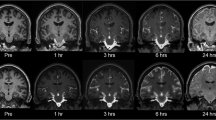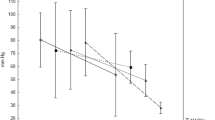Summary
Lumbar myelography was carried out with the contrast media Amipaque, Dimer X and Myelografin in 10 patients each. Five of the patients treated with each contrast medium were kept in a sitting position after the examination, the others lay flat. Blood levels and excretion were measured up to 24 h. The results are interpreted as follow:
-
1.
After lumbar injection of the contrast media there is a short phase of distribution in the subarachnoid space (lag time) and they then are transferred into the blood with a half-life of 3.9±2.4 h. The transport from the CSF is almost completed approximately after 24h. The velocity of transport varies greatly between the individual patients. Watersoluble contrast media presumably flow passively with the CSF through the arachnoid villi into the venous blood.
-
2.
The horizontal position of the patient reduces the lag time until the beginning of the actual transfer of the contrast medium.
-
3.
The transfer of Dimer X begins somewhat later compared with Amipaque and Myelografin.
Similar content being viewed by others
References
Amundsen, P., Foss, P.O., Godal, C.Ch., Nitter-Hauge, S.: Intravenous injections of metrizamide into human volunteers. Acta radiol. Suppl. 335, 339–345 (1973)
Braband, H., Lessmann, H.D., Wenker, H.: Experimentelle Untersuchungen über die Elimination und Neurotoxizität eines neuen, wasserlöslichen Kontrastmittels zur lumbosakralen Myelography. Radiologe 12, 66–68 (1972)
Cecile, J. P., Regnier, G., Guaquiere, A. Doffiny, L., Cuvelier, A.: Postural protection against complications in radiculography with Dimer X. Neuroradiology 7, 167–172 (1974)
Cserr, H.F.: Physiology of the choroid plexus. Physiol Rev. 51, 273–307 (1971)
DiChiro, G., Schellinger, D.: Computed tomography of spinal cord after lumbar intrathecal introduction of metrizamide (computerassisted myelography). Radiology 120, 101–104 (1976)
Dittmer, D. S. (Ed.): Blood and other body fluids. Federation of American Societies of Experimental Biology, 1961
Drayer, B. P., Rosenbaum, A. E.: Suprasellar masses on computerised tomography with intrathecal metrizamide. Lancet 1976, 736–738
Elies, W., Todorow, S.: Beobachtungen über den Resorptionsweg eines öligen Kontrastmittels (Duroliopaque) nach spinaler Myelographie. Fortsch. Röntgenstr. 120, 603–608 (1974)
Golman, K.: Absorption of metrizamide from cerebrospinal fluid to blood: Pharmacokinetics in humans. J. pharm. Sci. 64, 405–407 (1975)
Heinzel, G., Hammer, R., Wolf, M., Koss, F. W., Bozler, G.: Modellentwicklung in der Pharmakokinetik III. Teil: Vereinfachte Regeln zur Verteilung von analytischen Lösungen für lineare Kompartment-Modelle. Arzneimittel-Forsch. 27, 904–911 (1977)
Potts, D. G., Deonarine, V., Welton, W.: Perfusion studies of the cerebrospinal fluid absorptive pathways in the dog. Radiology 104, 321–325 (1972)
Schneider, M.: Physiologie des Menschen. Berlin, Heidelberg, New York: Springer 1966
Speck, U., Mützel, W., Nagel, R., Leistenschneider, W.: Pharmakokinetik und Biotransformation neuer Röntgenkontrastmittel für die Uro-und Angiographie beim Patienten. Fortschr. Röntgenstr. 127, 270–274 (1977)
Schlungbaum, W.: Verteilung, Ausscheidung und Resorption nierengängiger, mit J131 markierter Röntgenkontrastmittel. Fortschr. Röntgenstr. 96, 795–806 (1962)
Vogelsang, H., Speck, U., Becker, P., Blumenbach, L., Busse, O.: Ertahrungen mit einem neuen wasserlöslichen Kontrastmittel für die lumbale Myelographie (Vergleichende Untersuchungen mit anschließend aufrechter oder liegender Position). Röntgen Bl. 29, 201–206 (1976)
Wilson, J. W., Bahr, R. J., Leipold, H. W., Guffy, M. M. Acute leptomeningeal reaction to the subarachnoid injection of ethyl iodophenylundecylate in dogs. J. Amer. vet. med. Ass. 169, 415–418 (1976)
Author information
Authors and Affiliations
Rights and permissions
About this article
Cite this article
Speck, U., Schmidt, R., Volkhardt, V. et al. The effect of position of patient on the passage of metrizamide (Amipaque), meglumine iocarmate (Dimer X) and ioserinate (Myelografin) into the blood after lumbar myelography. Neuroradiology 14, 251–256 (1978). https://doi.org/10.1007/BF00418624
Received:
Revised:
Issue Date:
DOI: https://doi.org/10.1007/BF00418624




